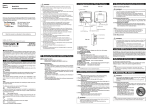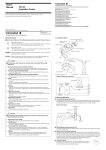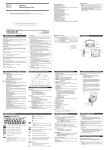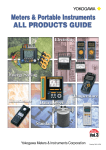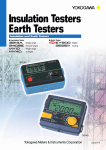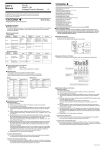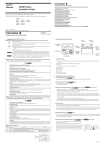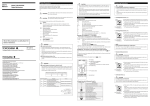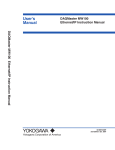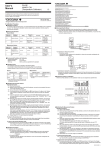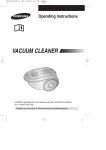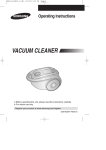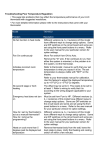Download IM MY10-E - Yokogawa
Transcript
User’s Manual 3. Components and Their Functions WARNING Model MY10 Insulation Resistance Tester Thank you for purchasing the Yokogawa Meters & Instruments MY10 Insulation Tester. To optimize all the functions of the instrument, please read this manual thoroughly before operating it. Store this manual in a safe place for future reference. 1st Edition : Jan. 2000(YG) All Rights Reserved, Copyright©1999, Yokogawa M&C Corporation IM MY10-E 6th Edition: Dec. 2006 (KP) ■ About This Manual The contents of this manual are subject to change without prior notice. Under absolutely no circumstances may the contents of this manual be transcribed or copied, in part or in whole, without obtaining permission. Every effort has been made to ensure accuracy in the preparation of this manual. Should any errors or omissions come to your attention however, please inform Yokogawa M&C Corporation accordingly. 1. Safety Precautions Always observe the following instructions. Failure to do so may result in electric shock or other dangers that may lead to serious injury or the loss of life. Yokogawa Meters & Instruments Corporation is in no way liable for any damage resulting from the user's mishandling of the tester. For safe use of this tester, the following safety symbols are used in the user's manual: WARNING Indicates a hazard that may result in the loss of life or serious injury of the user unless the described instruction is abided by. CAUTION Indicates a hazard that may result in an injury to the user and/or physical damage to the product or other equipment unless the described instruction is abided by. Note This provides important information for handling the tester and clarifies tester functions. The following symbols are used on the MY10 tester. Danger! Handle with Care. This symbol indicates that the operator must refer to an explanation in the user’s manual in order to avoid risk of injury or death of personnel or damage to the tester. High-voltage Terminal This symbol indicates a dangerous voltage level (terminals with voltages exceeding 1000 volts must be so marked). Never touch the terminals. AC Voltage This symbol indicates the presence of an AC voltage. Double Insulation This symbol indicates double insulation. ■ Always observe the following instructions. Failure to do so may result in electric shock or other dangers that may lead to serious injury or the loss of life. 1. During Measurement of Insulation Resistance • A high voltage is present at the probes. Do not touch the measured object or the earth or line terminal. 2. Immediately After Measurement of Insulation Resistance • The probes or the measured object may remain highly charged. Do not touch them immediately after the completion of measurement. 3. During Measurement of AC Voltages • Do not press the MEAS key while measuring AC voltages. • Voltage that exceeds the specified limit must not be applied to terminals. 4. Probes • Use the probes supplied by Yokogawa Meters & Instruments with this tester. • Do not use probes that have deteriorated or are defective. • Remove the probes from the measured object before attaching/ detaching the probes to/from the tester. 5. Insulation of Casing • A puncture in the protective insulation may occur if there are any cracks or other damage in the casing as a result of the instrument having been dropped or knocked against another object. Do not use the instrument before taking the necessary remedial measures; ask the manufacturer to repair it. 6. The Measured Object • Turn off the power to the measured object before you begin measuring insulation resistance. • Avoid touching any electrified parts while using the tester in a location with live electricity. For safety, it is recommended that you use a pair of rubber gloves or other alternative means. 7. Operating Environment • Do not operate the tester in an atmosphere where any flammable or explosive gas is present. • Do not use the tester if there is condensation on it. 8. Disassembly • No person, except personnel from Yokogawa Meters & Instruments, is authorized to disassemble this tester. ■ Measurement Categories Measurement category Description For measurements performed on circuits not directly connected to MAINS. Remarks 1 CAT.1 2 CAT.2 For measurements performed on circuits Appliances, portable equipments, etc. directly connected to the low voltage installation. 3 CAT.3 For measurements performed in the building installation. Distribution board, circuit breaker, etc. 4 CAT.4 For measurements performed at the source of the low-voltage installation. Overhead wire, cable systems, etc. Internal Wiring Entrance Cable CAT.4 Distribution Board • Turn off the power to the measured object before connecting the probes or measuring insulation resistance. • Electrical charges may be present in the cables attached to or metal of the electrical equipment being tested. Verify that the equipment is free from electrical charges before connecting the testing terminals. 2. MEAS key 9. Shoulder strap guide 6. ALARM LED 8. Battery cover 4. Protective cover fitting Outlet Equipment 2. Measuring Functions and Additional Features ■ Measuring Functions • Measuring the insulation resistance • Measuring AC voltages (sine wave at 50/60 Hz) ■ Additional Features • Discharge feature The tester is designed to begin discharging when the MEAS key is turned off. The ALARM LED turns off when discharging is complete. • Battery check This function verifies if the battery voltages are within the valid ranges. (When the battely is checked, the pointer must be within the BATT mark.) • Phosphorescent scale plate The indicator window lights up according to the intensity of light. • Locking the MEAS key Pulling the MEAS key up allows for continuous measurement over a prolonged period of time. 2. Connecting the Earth Probe • Securely connect the earth probe to the measured object’s ground line (if the measured object is not grounded, this process may be omitted). 3. Connecting the Line Probe • Bring the line probe into contact with the measured object, and then press the MEAS key. The pointer indicates the insulation resistance of the measured object. Note 7. Battery cover setscrew 3. BATT CHECK key 5. Zero adjustment (screw) 10. Earth terminal 11. Line terminal Side view 1. Indicator window 2. MEAS key 3. BATT CHECK key Verifies if the battery voltages are within the valid ranges. 4. Protective cover fitting 5. Zero adjustment (screw) 6. ALARM LED • Discharge feature (On➞ Off) When lit, it indicates that a capacitive component in the measured object remains electrified and will light up even if measurement has been completed. It turns off when discharge is complete. 7. Battery cover setscrew Undo to replace batteries. 8. Battery cover 9. Shoulder strap guide The shoulder strap is passed through it. 10. Earth terminal Connection for earth probe. 11. Line terminal Connection for line probe. During measurement, exercise care to prevent the leadwire of the line probe from coming into contact with the ground, floor or any other object. Not observing this precaution may result in a failure to measure the correct insulation resistance. 4. After Measurement WARNING • Immediately after measurement, electrical charges resulting from the applied testing voltage may remain present in the probes or measured object. • The tester, therefore, is designed to automatically begin discharging electricity upon completion of measurement. Verify that the ALARM LED turns off when discharging is complete. Locking the MEAS Key (for Continuous Measurement) The MEAS key, when pulled up to the right, can be locked to ensure the key remains turned on. Use this mechanism when making continuous measurement over a prolonged period. Note, however, that leaving the key turned on for an unreasonably long time will accelerate the discharge of the batteries. Battery Life (reference only) For MY10-03 at rated 500 V/100 MΩ: Approximately 10 hours when in continuously operation with central indication (approx. 2 MΩ; with standard supplied batteries). Note Note T 1. Before Connecting the Probes WARNING 1. Indicator window CAT.3 CAT.2 CAT.1 Fixed Equipment, etc. Rear view Front view 5. Measuring the Insulation Resistance • GUARD function is not a standard function. 4. Before Measurement 1. Safety • Read the handling precautions in this manual carefully. • Make sure it is safe before starting measurement. 2. How to Read the Scale • Read the value from the top-right of the scale. 3. Zero Adjustment • Confirm that the pointer is at the center of the infinity sign (∞); if it is, do not press the MEAS key. • If it is not, adjust the pointer to indicate the center of the infinity sign (∞) with the zero adjustment screw using a slotted screwdriver. 4. Battery Voltage Verification • Press the BATT CHECK key to make sure the battery voltages are within the valid ranges. (When the battely is checked, the pointer must be within the BATT mark.) • If the batteries are low, replace them as specified in the battery replacement section of this manual. 5. Connecting the Probes • Plug the earth probe into the earth terminal. • Plug the line probe into the line terminal. WARNING • Remove the probes from the measured object before attaching/ detaching the probes to/from the tester. • Make sure the MEAS key is off when attaching/detaching the probes to/from the tester. The data above is typical. Nevertheless, the battery life varies depending on the operating conditions. Check the batteries before measurement. 6. Measuring AC Voltages WARNING • Do not press the MEAS key while measuring AC voltages. Otherwise, it may result in a failure. • Voltage that exceeds the specified limit must not be applied to terminals. 1. Connecting the Earth Probe • Securely connect the earth probe to the measured object’s ground line (if the measured object is not grounded, this process may be omitted). 2. Connecting the Line Probe • Bring the line probe into contact with the measured object. The pointer indicates the AC voltage. Read the value on the voltage measurement scale (~ V). If the voltage of 20 V AC or more is present between the earth and line terminals, the ALARM LED turns on. Note When measuring insulation resistance, the tester can also be used to verify that there is no voltage present at the measured object. 7. Specifications 8. General Specifications 11. Accessories ■ Standard Accessories MY10-01 Model MY10-02 MY10-03 MY10-04 MY10-05 125 V/20 M Ω 250 V/50 M Ω 500 V/100 M Ω 500 V/1000 M Ω 1000 V/2000 M Ω Central Indication 0.5 M Ω 1MΩ 2MΩ 20 M Ω 50 M Ω 1st Effective Measuring Range 0.02 to 10 M Ω 0.05 to 20 M Ω 0.1 to 50 M Ω 1 to 500 M Ω 2 to 1000 M Ω 2nd Effective Measuring Range 0.01 to 0.02 M Ω 10 to 20 M Ω 0.01 to 0.05 M Ω 20 to 50 M Ω 0.05 to 0.1 M Ω 50 to 100 M Ω 0.5 to 1 M Ω 500 to 1000 M Ω 1 to 2 M Ω 1000 to 2000 M Ω Rating Lower Measuring Limit of Resistance 0.125 M Ω 0.25 M Ω 0.5 M Ω 1MΩ 2MΩ Rated Current 1 to 1.2 mA 1 to 1.2 mA 1 to 1.2 mA 0.5 to 0.6 mA 0.5 to 0.6 mA 0 to 250 V 0 to 300 V 0 to 500 V 0 to 500 V 0 to 500 V AC Voltage Measuring Range Operation temperature and humidity Storage temperature and humidity Battery External dimensions Weight Safety standards EMC Standard Effect of radiation ilmmunity ■ First and second effective measuring ranges 0 ∞ <1> <2 > <2 > Tolerances under the above conditions Resistance measurement: ±5% of reading within the 1st effective measuring range ±10% of reading within the 2nd effective measuring range Infinity and zero indications: 0.7% or less of scale length AC voltage: ±10% of the maximum value No-load voltage: Within 130% of the rated voltage Short-circuit current: 12 mA or less Scale length: Approx. 78 mm Item Standard test conditions Ambient temperature and humidity: 23 ±5°C at 45 to 75% RH Position: Horizontal (within 5 degrees) Influence of external magnetic field: Earth magnetism Battery Voltage : Within effective range for the battery (When the battery is checked, the pointer must be within the BATT mark.) Limit Test condition From the instant the resistors whose values correspond to central indication and zero indications are abruptly connected, to when the pointer reaches a level within tolerance Response time 3 sec or less Friction No friction is recognized Effects of inclination 2% or less of the scale length Effect of temperature (1) 5% or less (2) 0.7% or less of scale length (1) Deviation from central indication when ambient temperature is varied from 20°C by ±20°C (2) Deviation from infinity and zero indications when ambient temperature is varied from 20°C by ±20°C Effect of humidity Within tolerance When the tester is left for 1 hour with the humidity at 90% RH Effect of external magnetic field 3% or less of indication The change of indication when an external field of 400 A/m DC is applied in the most affected direction Effect of AC component of measuring terminal voltage 10% or less of indication A change when a capacitor with 5µF ±10% is connected in parallel to a resistor corresponding to central indication connected Insulation resistance 50MΩ or more (between electric circuits and outer case) When tested at 500 V if the rated measuring voltage is 500 V or less or at a voltage identical to the rated voltage if the rated voltage exceeds 500 V Deviation from the infinity indication when the tester is tilted from a horizontal position by 30 degrees Dielectric withstand voltage There must not be an abnormality. (between electric circuits and outer case) When a sine wave, or the like, is applied between the electric circuits and the outer case at 5550 V AC and 50/60 Hz for 1 minute Resistance to vibration The specifications for tolerances, friction, and the effect of tilting must be met. There are no mechanical and electrical damage. When a vibration frequency of 16.7 Hz and peak-to-peak amplitude of 4 mm is applied in the direction of the axis of the moving part for 1 hour Resistance to shock The specifications for tolerances, friction, and the effect of tilting must be met. There are no mechanical and electrical damage. When shock of 1000 m/s2 is applied twice in the direction of axis of the moving part and in a direction perpendicular to the axis Endurance The specifications for tolerances and friction must be met. When a resistor corresponding to the central indication is connected across the measuring terminals and the power switch is repeatedly turned on and off 10 000 cycles at a rate of about 300 cycles/hour Input over-voltage protection There must not be an abnormality. When an AC voltage of 50/60 Hz at 1.2 times the rated measuring voltage is applied to the measuring terminals for 10 seconds AA-size (4), [R6] Approx. 125 (W) × 103 (H) × 52.5 (D) mm Approx. 500 g (main unit and batteries only) Approx. 600 g (main unit, batteries, protective cover, earth probe and line probe) EN61010-1, EN61010-2-31 Insulation class2,Pollution degree 2 Measurement category3 (maximum input voltage: 600 V) EN55011 ClassB Group1 EN61326 ClassB At the strength of radio-frequency electromagnetic field of 3 V/m • Insulation resistance measurement 1st effective measuring range : ±10% of rdg 2nd effective measuring range : ±20% of rdg Infinity and zero indications : 1.4% or less of scale length • AC Voltage measurement : ±10% of FS 9. Using Protection Cover and Shoulder Strap The tester comes with a protection cover and shoulder strap as standard accessories. • The protection cover can be used as a front cover (for the indicator window) or as a bottom cover. Protection cover fixing holes (It is set as the front cover when Shoulder strap delivered from the factory.) • Using the shoulder strap allows A you to position the tester in B front of your chest for ease of reading. Pass the strap through the shoulder strap guide and adjust the length of the strap to allow you a good view of the tester. • Remove the cover from the front, and attach it to the bottom using the fixing hole (B) on the surface Protection cover of the cover. This is useful when Shoulder strap guide the scale is too close to your body to see clearly (See the figure on the right). • A belt on the cover which is fitted with pieces of Velcro, can be used to store the probes (Remove the probes from the tester terminals when storing them). 10. External Dimensions Main unit 125 (4.92) 52.5 (2.07) Unit: mm (approx. inch) Earth probe 1200 (47.24) Line probe 1200 (47.24) Model No. Protection cover Shoulder strap Line probe Earth probe Batteries User’s manual -10 to 60°C at 70% RH or less (no condensation) 103 (4.06) <1> 1st effective measuring range <2> 2nd effective measuring range The values which belong to both the first and second ranges in the table above, are included in the first range. Central indication Name 0 to 40°C at 90% RH or less (no condensation) Quantity 93013 99005 98001 98002 — IM MY10-E 1 1 1 1 4 1 ■ Optional Accessories Name Model No. Description 1. Spare probe tip for the line probe (Model 98001) 99011 105 mm, breaker pin 2. Hard case 93015 Houses both the main unit, the line probe and the earth probe. 3. Accessory bag 4. Replaceable-type line probe B9108XA 98005 Soft case, approx. 100 (W) ⫻ 190 (H) ⫻ 40 (D) mm Cable length: 1000 mm 5. Spare probe tips for the line probe (Model 98005) B9600GN 58 mm, general-purpose 6. B9600NW 360 mm, hook-shaped 7. B9600NX 360 mm, for extension purposes 8. B9600NZ 108 mm, sharp-pointed 9. B9635JK 338 mm, pickax-shaped 12. Battery Replacement WARNING • Remove the probes from the tester and then turn off the MEAS key before opening the casing to replace the batteries. • Do not touch the MEAS key during replacement. Otherwise, a high voltage may be produced. 1. Loosen the battery cover setscrew, and then slide the cover off of the main unit. 2. Replace all of the 4 batteries at the same time and make sure the polarities of the new batteries are exactly as shown on the battery holder. 3. After replacing the batteries, attach the battery cover and tighten the setscrew. CAUTION • Do not mix batteries of different types or new batteries with used ones. • Always remove the batteries if the tester will not be used for a prolonged period of time. If you store the tester with the batteries left installed, fluid is likely to leak from them, resulting in a malfunctioning of the instrument. 13. Maintenance ■ Storage Conditions • Temperature and humidity:-10°C to 60°C at 70% RH or less • Remove the batteries before storing the tester. • Avoid storing the tester in a location where there is: moisture; exposure to direct sunlight; a high-temperature heat source nearby; exposure to severe mechanical vibrations; a large amount of dust and/or salt, or a corrosive gas. ■ Removal of Dirt Do not use volatile solvents (such as paint thinners or benzine) as they are likely to cause discoloration. Wipe off dirt with a cloth dampened water or alcohol. ■ Calibration Cycle It is recommended that the tester be calibrated once every year for correct operation; ask Yokogawa M&C to do the periodic calibration for you. Yokogawa Meters & Instruments Corporation International Sales Dept. Tachihi Bld. No.2, 6-1-3, Sakaecho, Tachikawa-shi,Tokyo 190-8586 Japan Phone: 81-42-534-1413, Facsimile: 81-42-534-1426 YOKOGAWA CORPORATION OF AMERICA (U.S.A.) Phone: 1-770-253-7000 Facsimile: 1-770-251-2088 YOKOGAWA EUROPE B. V. (THE NETHERLANDS) Phone: 31-334-64-1611 Facsimile: 31-334-64-1610 YOKOGAWA ENGINEERING ASIA PTE. LTD. (SINGAPORE) Phone: 65-6241-9933 Facsimile: 65-6241-2606 YOKOGAWA AMERICA DO SUL S. A. (BRAZIL) Phone: 55-11-5681-2400 Facsimile: 55-11-5681-1274 YOKOGAWA MEASURING INSTRUMENTS KOREA CORPORATION (KOREA) Phone: 82-2-551-0660 to -0664 Facsimile: 82-2-551-0665 YOKOGAWA AUSTRALIA PTY. LTD. (AUSTRALIA) Phone: 61-2-9805-0699 Facsimile: 61-2-9888-1844 YOKOGAWA INDIA LTD. (INDIA) Phone: 91-80-4158-6000 Facsimile: 91-80-2852-1441 YOKOGAWA SHANGHAI TRADING CO., LTD. (CHINA) Phone: 86-21-6880-8107 Facsimile: 86-21-6880-4987 YOKOGAWA MIDDLE EAST E. C. (BAHRAIN) Phone: 973-358100 Facsimile: 973-336100 LTD. YOKOGAWA ELECTRIC (RUSSIAN FEDERATION) Phone: 7-095-737-7868 Facsimile: 7-095-737-7869 IM3E-2006.2


